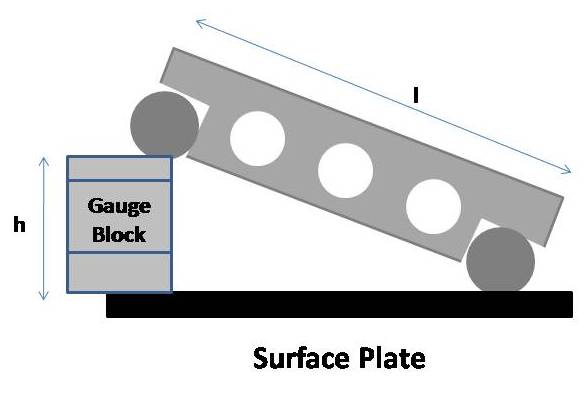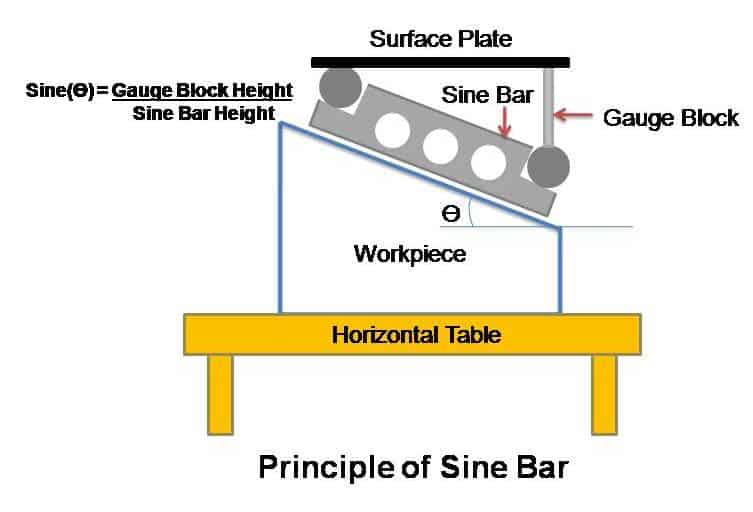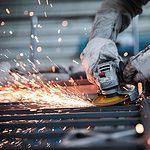Sine Bar is a precision measuring instrument used to measure the angular deviation or tilt of a surface with respect to a reference level in metrology. It is an extremely accurate instrument, capable of measuring angles up to 0.01 degrees.
A sine bar is made up of two precision ground cylinders attached to each end of a hardened, precision ground body. The distance between the cylinder centers is precisely controlled, and the bar’s top is parallel to the centers of the two rollers. When in use, the dimension between the two rollers is chosen to be a whole number (to facilitate subsequent calculations) and forms the hypotenuse of a triangle.
When it is placed on a flat surface, its top edge will be parallel to it. This instrument works on Sine Rule in which
● The hypotenuse is always the same length of sine bar. (100 mm or 10 inches in the examples shown).
● The height is calculated by measuring the distance between the bottom of one roller and the table’s surface.
● The sine rule is used to calculate the angle (a trigonometric function from mathematics). Some engineering and metalworking reference books include tables that show the dimensions required to obtain an angle ranging from 0 to 90 degrees at 1-minute intervals.
Sin(angle) = (Perpendicular/Hypotenuse)
It shows this tool can be used to measure or set angles.
This bar is made of high carbon, high chromium steel, which is corrosion resistant. This material is used to make sign bars to prevent wear and tear from handling.
What is Sine Bar?
Sine Bar existence lies in the fact that when two surfaces are placed at an angle to each other, the distance between them is proportional to the sine of that angle. This means that if two surfaces are placed a known distance apart at an unknown angle, the angle can be calculated by measuring the distance between them. To achieve this, the Sine Bar has two surfaces that are separated by a known distance and then adjusted to the angle being measured.
A sine bar, a gauge block, a dial gauge, or a spirit level is used to measure angles. The goal of a measurement is to make the surface where the dial gauge or spirit level is placed horizontal.
As an example:
To be measured, a wedge is placed on a horizontal table.
The sine bar is placed on the wedge’s inclined surface. The top surface of the this bar is tilted like a wedge in this case. Gauge blocks are used to make the top surface horizontal.
The sine of a wedge angle of inclination is a ratio of gauge block height to cylinder center distance.
When a sine bar is placed on a level surface, its top edge will be parallel to it. When one roller is raised by a known amount, typically with gauge blocks, the top edge of the bar is titled by the same amount, yielding an angle calculated with a sine rule.
- The length of the hypotenuse is always the same.
- Height is calculated by measuring the distance between the bottom of one roller and the table surface.
- The angle is calculated using the sine rule. The dimension required to obtain an angle ranging from 0° to 90° was increased in 1-minute increments. sine = hypotenuse/opposite
- This tool can be used to measure and set angles.
Formula of sine bar:
It states that the sine of any given angle (θ) is equal to the distance (d) between the two surfaces divided by the known distance between them. In other words, sine θ = d/L.
This equation is used to calculate the angle of the Sine Bar, which is then recorded on the scale along with its corresponding value.
Trigonometry is used to calculate the sinθ.
Sineθ = Opposite/Diagonal
Cosθ = Opposite/Diagonal
Tanθ = Opposite/Concurrent
One roller is set on a surface plate, while the other is set at height h by a slip gauge. L denotes the distance between the Sine Bar’s two setting rollers.
The trigonometric formula shown above Above Sine = opposite/diagonal = h / L
This allows us to write θ = sin^-1 (h / L).
This is the sine bar formula for calculating or setting the workpiece to the required angle.
Why is the sine bar limited to 45 degree angle?
The Sine Bar is limited to a maximum of 45 degrees as any angle greater than this would cause the two surfaces to come into contact. This would not only affect the accuracy of the measurement, but could also damage the Sine Bar itself.
We know that the basic principle of sine bar operation is sinθ = h/l.
By differentiating the above equation,
cosθ . dθ = l.dh – h.dl
or
dθ =tanθ(dh/l – dl/l)
This indicates that error is a function of tanθ and that error is smaller below 45 degrees but it can suddenly increase above 45 degrees. As a result, sine bars are preferred for measuring angles less than 45 degrees.
Construction:
The sine bar’s gauge body is made of a rigid material such as steel. Two rollers are located at the end of the steel bar. The rollers are the same diameter and their axes are parallel. The top of the steel bar parallels the line running through the centers of the two rollers and the length of the sine bar equals the distance between the centers of the two rollers.
To reduce the weight of the sine bar, relief holes are provided.
It cannot be used to measure the angles of a component on its own. The sine bar is always used when measuring angles with slip gauges, surface plate and dial gauge
Surface Plate:
A surface plate supports the sine bar and other components such as slip gauges and height gauges. The surface plates are assumed to provide a precise horizontal surface. When we place a sine bar on a surface plate, the top surface should be parallel to the horizontal surfaces of the plate.
Dial Gauge:
To check surface uniformity, a dial gauge is used. If a dial gauge shows zero deflections while traveling on a surface, we can say it is parallel to its base. Dial gauges are used in the sine bar arrangement to determine whether the upper surface of the workpiece is parallel to the surface plate or to determine the angle of the workpiece’s tapered sine.
Slip Gauges or Block Gauges:
These are precision measuring instruments such as block gauges and slip gauges are used to determine the height or length of an object.
Vernier Height Gauge:
By measuring the height of the sine bar’s roller, a vernier height gauge is used to calculate the angle of a larger component.
Sine Bar is Used for ?
It can be used to measure the angle of a surface with respect to a reference level or to detect any variation in that angle over time. The applications of it are numerous.
For Examples:
- In research and development processes, the Sine Bar is used to measure angles of interest in order to study their effects on a given system or process. This helps researchers develop better products and improve existing ones.
- The sine bar is used to set or determine the angle of a workpiece.
- It’s used to double-check the measurement of unknown angles in a workpiece.
- To mount the workpiece and perform conical-shaped machining, some specially designed sine bars are used.
- It is used to look for unidentified angles in heavy components.
- This can be used to check the taper key’s angles.
- It is used to ensure that the surface is flat.
- It is also used in the automotive and aerospace industries to measure the alignment of components such as engines and wings.
- In addition, These are often used in the construction industry to measure angles between structures, such as stairs and walls.
- Finally, the Sine Bar is a useful tool for machinists and engineers who need to check the accuracy of their work.
What is Limitations of Sine Bar?
It has the following limitations:
- Any unidentified projections in the component will result in measurement errors.
- It is limited to measure angle less than 45 degree.
- Because there is no scientific method for creating slip gauges, they must be constructed through trial and error, which is a time-consuming process.
- The length of the sine bar used to measure the angle must be greater than or equal to the length of the component to be inspected.
- If the length of the inspected component is too long, no sine bar longer than the component is available.
Conditions for Accurate Reading:
- The sine bar’s two roller axes must be parallel to each other.
- The upper surfaces of the this bar should be perfectly parallel and flat.
- The sign bar’s rollers should all be the same size.
- The distance L between the centers should be precisely measured.
Summary:
Sine Bar is an invaluable tool for anyone working in the field of metrology. Its accuracy makes it ideal for precision measuring applications. With its ability to measure angles up to 0.01 degrees, it is a must-have instrument for any job requiring accurate measurements and reliable performance.
From its simple construction and formula to its many applications, it is an essential tool for ensuring accurate measurements and improved machine performance.
Thanks for reading! I hope this article provides you with a better understanding of the sine bar and how it can be used to make accurate measurements. Good luck!



